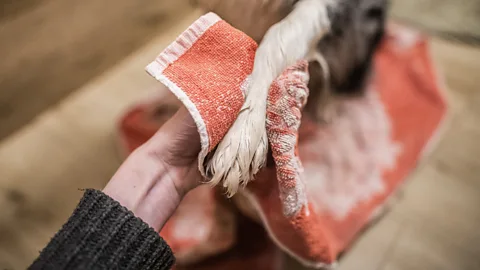 Getty Images
Getty ImagesThe towels we dry ourselves with get a lot of use and pick up a lot of microbes along the way. But how long should you wait before throwing them into the laundry?
And while those fluffy fibres might not show any signs of dirt, they are a breeding ground for millions of microbes. Studies have shown that towels can quickly become contaminated with bacteria commonly found on human skin, but also with those found in our guts.
Even after washing, our bodies are still covered in microbes and perhaps unsurprisingly when we dry ourselves off, some of these transfer onto our towel. But the microbes living on our towels come from other sources too – airborne fungi and bacteria can settle on towel fibres while they are hanging up. Some of the bacteria comes from the water we have used to launder the towels with in the first place.
In Japan, some households even reuse leftover bathwater for laundering the next day. One study by researchers at the University of Tokushima in Japan found, while this saves water, many of the bacteria found in the used bath water were then transferred to towels and clothing after being laundered.
Over time these microbes can start to form biofilms on towels that can even begin changing how our towels look. After two months, even with regular washing, the bacteria living on cotton towel fibres start to dull the appearance of the cloth. But perhaps unsurprisingly, the total amount of bacteria and the species of bacteria depends on the laundry habits in the household. The real question is, how worried should you be about the bacteria living on your towels?
 Getty Images
Getty ImagesThe topic of towel washing might seem trivial, but Elizabeth Scott, a professor of biology and co-director of the Simmons University Center for Hygiene and Health in Home and Community in Boston, the US, is interested in what it can reveal about the way microbes spread around the home.
“They’re not just naturally sitting around on towels,” she says. “Anything that causes us harm on a towel is likely to have come from a human.”
Indeed, there are as many as 1,000 different species of bacteria living on our skin alongside many other viruses and fungi. But most are actually good for us – helping to keep us safe from infections from other less friendly bacteria, breaking down some of the chemicals we encounter in daily life and playing an important role in the development of our immune systems.
Perhaps the biggest problem occurs when we pick up potentially harmful microbes up on our hands as we dry them off before touching our mouth, nose and eyes. And that can mean the towels we use most frequently for our hands, perhaps deserve more attention. Kitchen towels, which are used on our dishes, hands and surfaces, are also another source of spread for foodborne pathogens.
 Getty Images
Getty ImagesBut thinking about towel hygiene could also help combat one of the major health issues facing the world, according to Scott and her colleagues. Antibiotic resistant bacteria, such as MRSA, can be transferred by contact with contaminated objects.
Jean-Yves Maillard, professor of pharmaceutical microbiology at Cardiff University, says practices like regular towel washing can help to reduce bacterial infections and in turn reduce the use of antibiotics. “Home hygiene is all to do with prevention, and prevention is better than treatment,” says Maillard.
So, how often should we be washing our towels?
Scott suggests laundering towels once a week. However, this recommendation is not a set rule.
“It doesn’t make a whole lot of sense because if someone is sick, they’ve got vomiting and diarrhoea,” she says. “They need to have their own towel and those towels need to be laundered on a daily basis. That’s what we call targeted hygiene, you deal with the risk as it occurs.”
For washes at lower temperatures, adding enzymes or bleach can help combat microbes on towels. One study in India also found combining a wash with a detergent with a disinfectant while rinsing and drying towels in the Sun was the most effective at reducing the bacterial and fungal load.
Scott refers to home hygiene as a form of altruism, much like vaccination. Each small practice you undertake to protect yourself, you also do to protect the people around you.
“We call it the Swiss cheese model,” she says. “We think of all of these components as being slices of hygiene, like slices of Swiss cheese and every slice of hygiene covers up one of those holes and reduces the risk of pathogens being able to move through.
“Towels are a relatively small component, but there are definite risks with towels and it’s easy to deal with that.”
